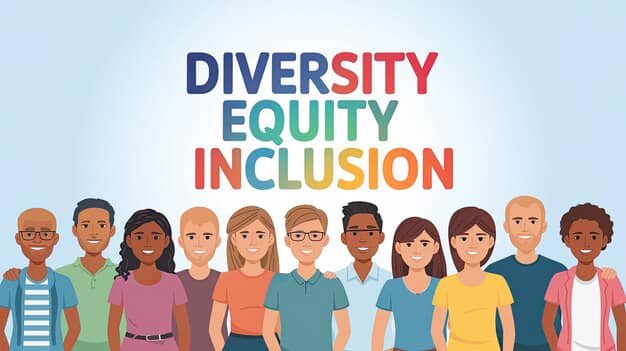In recent years, “Diversity, Equity, and Inclusion” (DEI) have become a central focus in the corporate world, with companies of all sizes emphasising their commitment to building a diverse workforce and creating equitable and inclusive environments. However, as the conversation about DEI grows louder, it’s crucial to move beyond the buzzwords and ensure these concepts are truly embedded into workplace culture and business practices.
To make meaningful change, organisations must understand what each term means, why they are essential, and how to take tangible actions toward creating a genuinely diverse, equitable, and inclusive environment.
Understanding Diversity, Equity, and Inclusion
Before diving into actionable strategies, it’s important to understand the core concepts of DEI:
Diversity refers to the representation of a range of differences within a group, whether those differences are based on race, ethnicity, gender, age, sexual orientation, abilities, religion, or socioeconomic background. A truly diverse workforce includes people from varied backgrounds who bring different perspectives and experiences to the table.

Equity involves creating fair opportunities for all employees by acknowledging and addressing systemic inequalities that prevent marginalised groups from having equal access to resources and advancement. Unlike equality, which assumes everyone starts at the same level, equity recognises that some individuals may need more support to reach the same outcomes.
Inclusion is the practice of ensuring that all employees feel valued, respected, and integrated into the workplace culture, regardless of their backgrounds. It’s about creating an environment where everyone’s voice is heard, and everyone has the opportunity to contribute meaningfully to the organisation’s success.
The Business Case for DEI
Moving beyond the surface level of DEI requires a clear understanding of its importance, not just from a social justice standpoint but also from a business perspective. Numerous studies have shown that diverse teams are more innovative, perform better financially, and foster better decision-making.
According to a report from McKinsey & Company, companies with more diverse executive teams are 36% more likely to outperform their peers in profitability. Additionally, inclusive workplaces tend to have higher employee engagement, satisfaction, and retention. When employees feel included, they are more likely to stay with the company, reducing turnover costs and maintaining institutional knowledge.

From a customer perspective, diverse teams are better equipped to understand and serve a broader range of clients, as they can draw on a wide variety of experiences and insights. As the world becomes increasingly globalised, companies that embrace DEI are better positioned to compete and thrive.
Moving Beyond the Buzzwords: Actionable Strategies
While many companies publicly pledge their commitment to DEI, making real progress requires more than just talking about it. The challenge lies in translating these ideals into concrete actions that drive lasting change. Here are some actionable strategies for moving beyond DEI as a buzzword:
Leadership Accountability
Leadership plays a critical role in advancing DEI initiatives. Executives and managers must be fully committed to these goals, not just in rhetoric but in action. Leaders should regularly assess their company’s DEI performance, set measurable targets, and take accountability for progress. This includes increasing diverse representation in leadership positions and ensuring inclusive decision-making processes.

Embedding DEI into Organisational Culture
To move beyond surface-level efforts, DEI must be deeply ingrained into the company’s culture. This means fostering an environment where diversity is celebrated, equity is a core value, and inclusion is practised daily. Companies should offer training programs that address unconscious bias and cultural competence while encouraging open dialogue about sensitive topics related to identity, privilege, and discrimination.
Data-Driven Approaches
Effective DEI initiatives are backed by data. Companies should conduct regular assessments to understand the current state of diversity within their workforce, identify areas of inequality, and track progress over time. This might involve analysing hiring data, promotion rates, pay equity, employee satisfaction surveys, and retention rates. Transparency is key. Sharing this data with employees can foster trust and demonstrate a commitment to improvement.
Fostering Diverse Talent Pipelines
One of the challenges companies face is building a diverse talent pipeline. To address this, organisations should expand their recruitment efforts beyond traditional sources and develop partnerships with schools, universities, and organisations that cater to underrepresented groups. Internships, mentorship programs, and training initiatives focused on developing diverse talent can also play a crucial role in supporting equity in career advancement.

Inclusive Policies and Benefits
Ensuring that policies and benefits reflect the needs of a diverse workforce is crucial. This can include offering flexible working arrangements, providing parental leave for all genders, implementing anti-discrimination policies, and creating safe spaces for underrepresented groups. Employee resource groups (ERGs) can also offer support and foster community among diverse employees, helping them feel more included in the workplace.
The Importance of Continuous Improvement
DEI is not a one-time effort—it requires ongoing commitment and adaptation. As societal expectations and workplace dynamics evolve, so too must DEI strategies. Regularly revisiting goals, seeking feedback from employees, and being open to change is essential to maintaining momentum. By fostering a culture of continuous learning and improvement, companies can ensure that their DEI efforts remain impactful and relevant.
